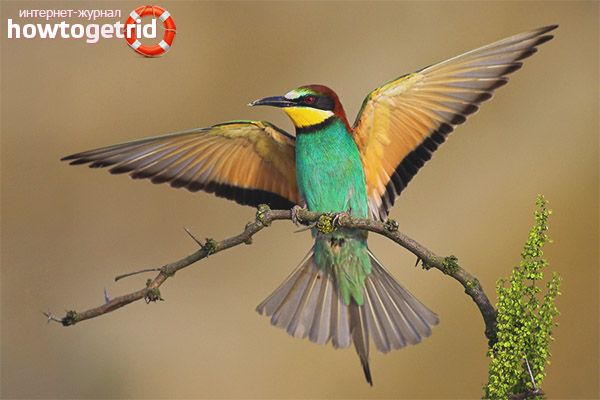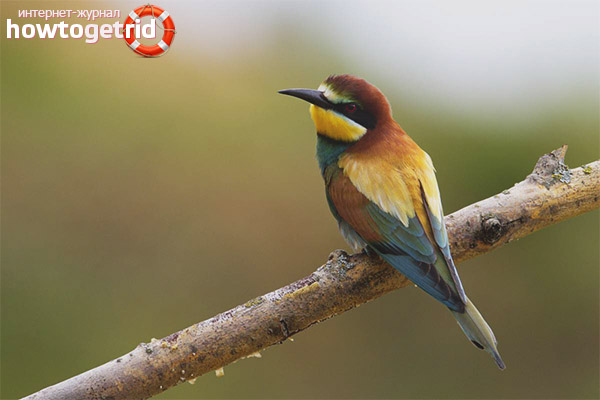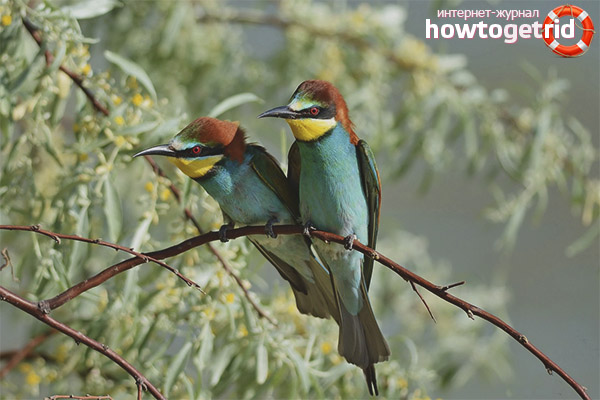The content of the article
The golden bee-eater is not difficult to recognize by the elongated forms of her body, as well as the motley plumage decorated with different colors. She knows how to skillfully pick up insects on the fly, but among others, the bird gives its preference to bees. Beekeepers are preoccupied with the habits of this bird and seek to protect themselves from its invasions. In total, there are 28 different species of bee-eater, of which 18 have chosen Africa as their habitat.
Features
In ancient times, this bird was called a bee-eater, its belonging to the family of bee-eater. It has several more names, two of which are scrofula and jaundice. The individual has a beak 3.5 centimeters long, which has a curved shape. In the area of the beak, the head is colored white, and closer to the crown it wears a bluish-green plumage.
From the beak to the ear, crossing the eye, there is a stripe of bright black color, and the bird's eyes are painted in blue. The plumage, located in the area of her throat, has a bright yellow character, a strip of black color separates it from the chest. Her back received a yellow-ocher color, and motley wings are composed of green, as well as brown and blue feathers. The tail of this bird is wedge-shaped, it is composed of greenish-blue plumage. The middle feathers of her tail are somewhat elongated, and her legs are painted a reddish-brown tint.
Favorite Habitats
Golden bee-eater is considered a migratory bird, capable of crossing long distances in its migrations. She prefers to spend summer in the southern and eastern part of Europe or in the south-western part of Asia, and in winter she flies to the African mainland, south of the desert region of the Sahara.
In addition, it can winter in southern Arabia or eastern India. It is noteworthy that if the area has a short summer period, accompanied by climate humidity, it is not suitable for bee-eater. For its nesting, this bird prefers to choose the spaces located in the north of Africa, selected areas of southwestern Asia or southern Africa. It has also been noticed that in Italy annually a population of bee-bees nesting at about 10,000 pairs, here they adhere to a height of 500 meters from sea level.
Features habits and lifestyle
These birds prefer to arrange their nests in burrows, which are located in the planes of the steep slopes of ravines or cliffs; various beams or steep banks of some rivers are also suitable for this purpose. In the steep surface of the selected area, birds arrange holes about 6 centimeters in diameter, dropping them about a meter from the top line of the horizontal plane.
Young chicks gain the ability to fly by mid-summer. These bee-eater return to their nesting sites in spring, from early April to mid-May.It is noteworthy that, going on a seasonal flight to the wintering places, the birds clog the entrance to their “apartment” with clay, thus preventing the settlement of other birds.
On fine days, when there is no wind and the sun is not covered by clouds, golden bee-evers prefer to hunt at high altitude, eating insects that have risen into the air. When atmospheric pressure does not allow insects to fly high, birds have to sink lower. But this is not a problem for them, because they are able to arrange their hunt almost at the surface of the soil, especially on cloudy days with rainy weather.
Flight features

The golden bee-eater is distinguished by dexterity and speed of flight, it carries out several energetic flapping of wings and soars at high speeds. Her flight can be compared with the flight of a swallow or starling, although sometimes she can use distinctive techniques. From time to time, she has to freeze in her flight, after which, operating with vigorous flapping of wings, the bird performs trembling actions, resembling the manner of a kestrel or fawn. When the weather pleases with clear days, these birds are able to ascend into the sky to a great height, from which they can no longer be distinguished.
Individual voice characteristics
A distinctive feature of the golden bee-eater is the bright colors of its colorful plumage. But no less individuality has an unusual bird voice. When taking off, they emit a piercing sound that is consonant with the sound of the “Pru-u-hipp” combination. And for ordinary communication, birds choose quieter and intermittent trills, although due to the pitch they are heard from a great distance. Silence of the bee-eater does not differ; their flight is able to be accompanied by continuous communication. During the period of wanderings, these birds like to choose single large trees, settling on their sprawling branches, and denote their presence by the muffled sounds of their voice.
Diet
An exceptional component of the diet of birds of this species are all kinds of insects. In addition, the bulk of their diet is represented by different types of flying insects. Although sometimes crawling representatives of the “insect kingdom”, who were not lucky enough to be on the tops of plants, can become prey for bee-eater.
An adult individual bee-eater is capable of absorbing up to 40 grams of various insects per day. In quantitative terms, 225 bees can represent this mass. The most coveted trophy for this bird is the representatives of the hymenopteran order, which are bees and wasps. This is followed by the bulk of flying insects, dipterans and orthopterans, which are mosquitoes, the larvae of numerous dragonflies, beetles, consisting of ground beetles and leaf beetles, as well as all kinds of butterflies. Among other things, these birds will not miss the opportunity to enjoy bumblebees and hornets, as well as midges.
Knowing that a favorite prey is able to inflict stings with a sting, the beetle adapted to crush the bees and wasps before swallowing them. After killing the prey, the bird slowly removes its insides.
Nesting period
Upon returning to the nesting sites in spring, golden bee-eater can withstand some pause necessary for adaptation. After that, the birds accumulate in places with steep surfaces, and arrange their nests close to each other. In very rare cases, birds are able to arrange their nests on flat surfaces.
In order for the hole to get the right shape and size, birds have to spend a lot of time. The beehives dig a hole with joint efforts, the female and the male alternately throw out the soil, backing away. They prefer to do construction work in the morning and evening hours. Much depends on the hardness of the soil, but on average birds build their holes in 10-20 days.The weight of the soil that the birds need to move is approximately 12 kilograms.
The length of the beehive hole can reach 2 meters, it ends with a recess, forming a chamber, which the female uses for her masonry, consisting of 6-7 eggs with a white shell. The incubation period of these birds is 20 days, both parents take part in this process. 25 days after the birth of young individuals gain the ability to fly.
Beekeeping Damage
If golden bee-eater settled down near the location of the apiary, then bees will become their main prey. One bee family consists of about 30 thousand individuals, an adult bee-eater is capable of destroying up to 2% of the population of this family per day. During the summer, a pair of bee-eater exterminates about 2,000 insects. And if a flock of bee-eater is located next to an apiary consisting of 50 families, then the income of this apiary will be reduced to 0.
There were cases when in the goiter of this bird there were about 180 working bees, and its tongue was speckled with insect stings. It is noteworthy that bee venom does not have any effect on the golden bee-eater. Birds of this species pose the greatest danger to beekeepers from July to mid-September.
The benefits of extermination of insect pests of the bee-eater bring very little, these characteristics serve as the main reason for the reduction in the population of these birds in many European regions. Indeed, in addition to the harm caused to beekeeping, bee-eater can seriously reduce the population of bumblebees necessary for pollination of clover.
Beekeepers and farmers are very unhappy with such neighborhoods and sometimes apply the most decisive measures to destroy pest birds. At night, when the bird family hides in a hole, they put a rag soaked in chloropicrin. After this, the hole becomes clogged, and all the inhabitants die. In addition, beekeepers are actively shooting this species of birds.
Video: golden bee-eater (bee-eater)











Submit